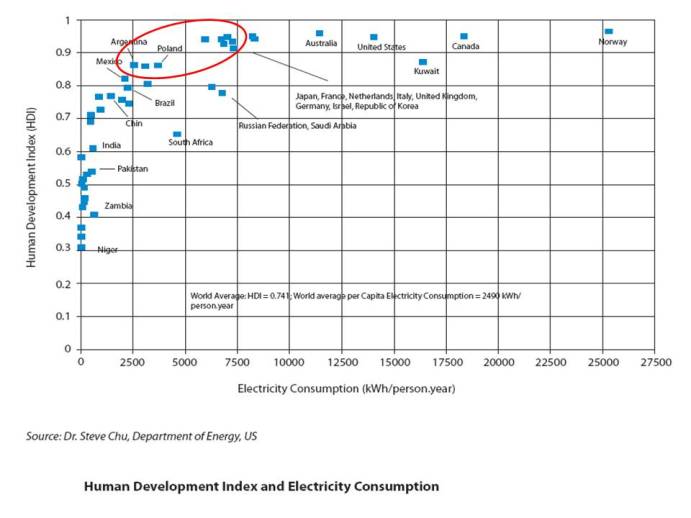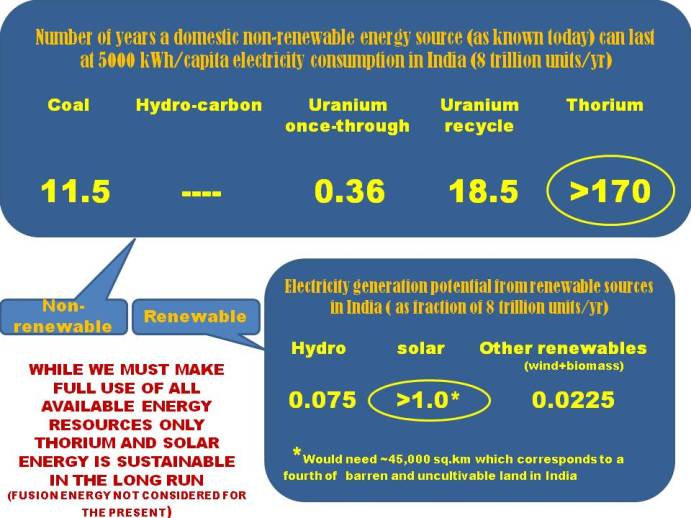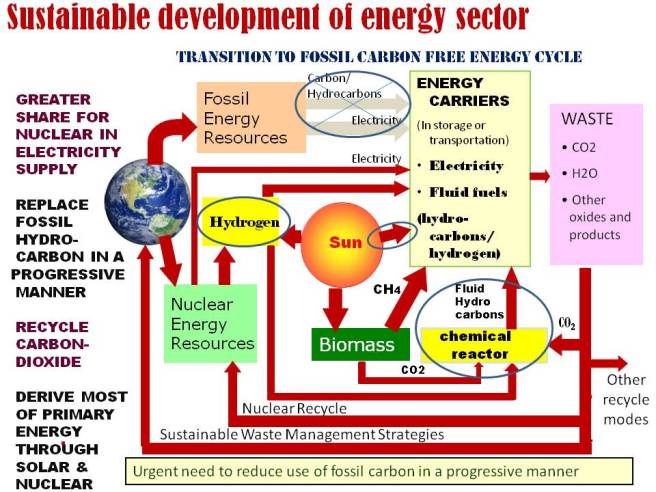
|
SOLAR ENERGY
|
RELATED ARTICLES
|
|
|
Solar Energy, the truly sustainable energy source
A quick look at Fig. 1 would suggest that we need around 5000 kWh/capita of electricity annually to reach a respectable human development index in our country. Being based on global statistics, in today's highly interconnected and interdependent world, we can surely depend on this number as a bench mark that we must achieve. Our current per capita electricity use is however a factor of seven lower. Unfortunately our population is also growing. Indications are that, we are likely to stabilize around 1.6 to 1.8 billion people. We thus need to secure energy resources and technologies to harness them at a level ten times larger than what we have at present.

Fig.1

Fig.2
On a personal note
I had an occasion to work on the design of a 20 MWe solar thermal plant ( tower version) in early nineties at the request of NTPC. The proposal unfortunately did not see its logical end presumably on account of lack of enthusiasm with regard to indigenous capability development in the concerned department at that time. Things have changed now and I am very happy to be involved in leading the solar energy development in the country.
Solar Energy Vision
As is clear from Fig.2, one fourth of the barren and uncultivable land in India (which would correspond to around 45,000 sq. kM) should be sufficient to collect solar energy to meet all our needs. Thus in addition to tapping solar energy where ever there is an opportunity without any land use conflict, one would need to develop technologies appropriate for large scale deployment in barren uncultivable areas away from populated regions.
New Solar Technologies
Some of these technological challenges include for example (i) self cleaning/dust repellent surfaces that sustain optical properties relevant to solar photovoltaic as well as solar thermal applications, (ii) negligible dependence on water, (iii) relatively maintenance free operations etc. Then there are other challenges which are a part of the race to make solar technologies more competitive and maximization of value addition activities within the country. These include reduction of capital costs for the energy generation plants through development of new technologies for PV cells (low cost, high efficiency, high temperature capability etc.), LEDs, batteries, tracking and controls, high performance reflector and absorber surfaces, glass, glass to metal seals etc. Adoption of strategies for deployment of hybrids of different kinds is also an important strategy for making deployment of solar energy technology cost competitive. High temperature (>300 degrees Celsius) capable PV cells would allow hybridization of solar photovoltaic and solar thermal technologies leading to a large jump in efficiency of conversion of solar energy, hybridization of solar energy particularly photo-voltaics with wind or biomass or for that matter other relevant energy sources would enable significant reduction in the need for energy storage capacity leading to significant saving in the capital cost. Apart from development of low cost, high power density electrical batteries, we need to pay attention to other energy storage systems such as pumped storage, thermal storage, chemical energy storage(for ex. hydrogen), kinetic energy storage etc. It is important that we create a network of R& D labs. and industries that accelerate domestic development of relevant technologies and facilitate building competitive domestic supply chain. Deployment Strategies - policy
Principle of competitive bidding along with policy initiatives such as capital or tariff subsidy, Renewable energy Purchase Obligations, Renewable Energy Certificates etc have given a significant boost to introduction of Solar Energy and growth of associated market. That coupled with cheap solar cells, panels and related hardware from China on one side and rise in the thermal power costs on the other, have brought solar energy fairly close to competitive level.
Basic materials and Component manufacturing capacity
There are however some challenges with respect to difficulties faced by Indian manufacturers in view of Chinese competition and vulnerability due to highly inadequate domestic production capacity for basic materials and components like silicon, LEDs, rare earths etc. Further policy initiatives are necessary to set up a reasonable capacity for these materials and components and support them to be able to compete in the global/Indian market. This is of crucial importance since we are talking about being one of the largest solar power users in the world. Stand alone solar powered agricultural pump sets
There are also other policy issues. For example today agricultural pumping constitutes a significant non-paying load on our electricity supply system that has made power to industry expensive with attendant adverse impact on the profitability of the industry and the growth of economy. Isolation of these pump sets from the grid and making them stand alone solar powered pump sets would not only free the power distribution companies from delivering power to non- paying customers but also lead to a much lower tariff for industries making them more competitive and spurring the growth of economy. One time heavy capital subsidy for stand alone solar energy driven pump sets thus makes huge economic sense. Since sun does not shine on 24x7 basis and solar insolation and the need for pumping would by and large be concurrent, such a strategy would also make some sense even in terms of optimum use of water. Need for a major rare earth initiative
Solar powered stand alone water pumping on a large scale could become much more energy efficient by adoption of d.c. motor driven pumps. While this would also save on cost of inverter, mass produced rugged rare earth permanent magnet based d.c. motors and efficient pumps could lead to paradigm change in agriculture economics. Fortunately, if we put our act together, we can produce rare earth magnets using our own resources. A major rare earth mission however is required to be launched to realize this proposition. Besides several applications of rare earth magnets themselves, such a mission would have several other high technology spin offs once low cost rare earth products are available in the country. Solar lights in rural areas
A similar opportunity exists with respect to domestic lighting in rural areas. Domestic lighting in rural areas, where grid supply has either not reached or there are long periods of power cut, is largely based on kerosene which entails fairly large recurring subsidy burden on the Government. Solar lights provide a way not only for better quality of light particularly for study of young children, but also for reduction of kerosene consumption for purpose of lighting. Further augmentation of onetime cost subsidy for greater penetration of solar lights in lieu of corresponding reduction of kerosene quota could be an overall budget neutral option bringing in improvement in both quality of life as well as national economy. Building solar lights based industry in rural areas
Large scale deployment of solar energy in rural areas would need a well distributed supply and services network available practically in every village. To make such a network viable, a substantial livelihood opportunity can be created in rural domain by organizing assembly of solar lights of approved and certified brands under franchise operation with appropriate quality control. A policy framework needs to be put in place to create and nurture a vibrant rural industrial activity around solar lights. Village electrification
Significant progress has been made towards rural electrification. Even so more villages where grid power is yet to reach are yet to be covered. Micro grids powered by solar-biomass or solar-wind hybrid power unit can become an attractive proposition for such villages. Such power units can also serve as standby power source for villages that suffer sustained power outages for long periods. Such hybrid power units as well as related village electrification where ever necessary can be set up using BOOT model implemented by village bodies. We need to set up support system for defining the contours of the project, specifications and project implementation oversight and hand holding of village bodies till they can handle things themselves. Energy taps
A lot of personalized devices such as mobiles, laptops, light torches etc. have significantly impacted our lives. They all depend on electricity and need to be periodically charged. They have started making significant impact in rural India as well. Mobile telephones have become important tools of empowerment of poor people through social and financial inclusion. More importantly, use of these devices and their transformative power is crucial to benefit from the emerging knowledge based economy in the A3 (anyone, anytime and anywhere) connected society. It is important that people in rural areas are made a part of main stream regardless of whether there is electricity in the village or not. Availability of solar powered facility for charging devices like mobile telephones and solar lanterns should thus be seen to be important as drinking water outlets in hot summer in villages. Locating such facilities in schools powered by roof top solar panels could facilitate children to bring their solar lamp batteries and get them charged while they are at school. This would ensure light for their studies regardless of availability of power supply in their homes. Conceptually this idea is similar to the midday meal scheme for rural school children. Solar Thermal technology
Solar thermal technologies would have a niche role for deployment of large capacity plants in areas where large tracts of barren uncultivable land are available. More importantly, solar thermal technology is more amenable to indigenous development as compared to the PV counterpart. (This is not to mean any less priority for indigenous development of PV technology which must continue to deployed unabated on lines being pursued presently and indigenous technologies brought in as early as possible). A comparative assessment of different solar thermal options suggests that an advanced version of LFR configuration with receiver in vacuum hybridized with photovoltaics would perhaps be the best choice for optimum land use where ever large tracts of reasonably plane land is available. On the other hand in case of highly undulating lands, heliostats with multiple towers and integral molten salt based thermal management would perhaps be an optimum solution. Here again one should seek to develop a possibility to adopt direct conversion to electricity (thermo electric/PV) with balance energy conversion through thermodynamic cycle. A beam down configuration with the receiver located on the ground could also be an attractive option as the heat loss can be further reduced with added ease in maintenance even though there would be some energy loss during optical transmission. It would be necessary to create reasonably large capacity demonstration cum development facilities around these configurations to be able to set up large scale solar thermal plants. R & D with Industry involvement
Clearly to develop technologies that are appropriate to Indian conditions as brought out above, we need to mobilize significant R&D effort. In order to realize robust and deliverable technologies, involvement of industries in this effort is a must. We must therefore set up a competitive mode of technology development in which R&D labs. and industries work together and participate as consortia. Quite apart from realization of technology needed for immediate deployment such mode of working would need to be sustained since technologies in the area of solar energy would be continuously evolving. Over a period of time one should expect solar energy along with nuclear energy becoming the mainstay for not only the electricity supply but also other modes of energy transport and usage. Carbon sequestration through recycle of carbon-di-oxide would also be a component of such a transformation. (see fig.3)  Fig.3
|
IMPORTANT LINKS
|
|
